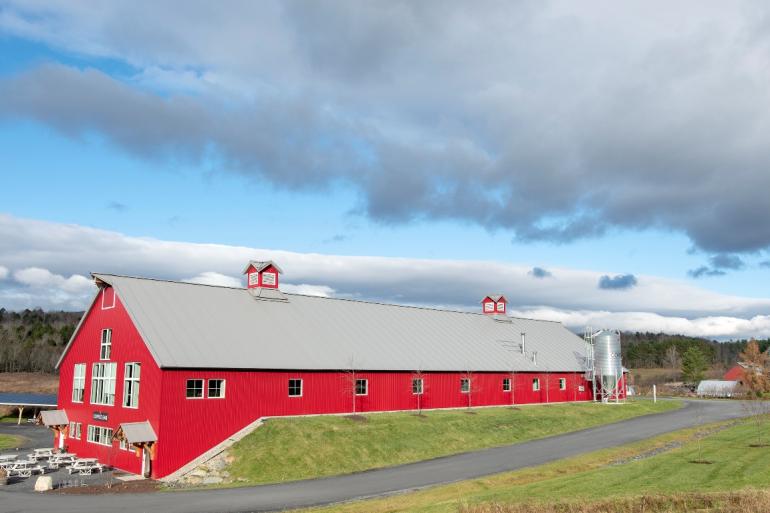
Wood: Vermont’s locally grown, renewable fuel
Pellet boilers produce significantly less air pollution while generating heat more efficiently than their traditional wood stove counterparts. Photos by Erica Houskeeper
by Christine McGowan, Forest Program Director, Vermont Sustainable Jobs Fund Vermonters have a long history of heating with wood, and most of us know there is nothing like the warmth of a well-stoked wood stove on a cold winter night. It is only in recent years, however, that advances in technology have made wood a convenient alternative to fossil fuels through whole-building, automated wood heat systems that are controlled by thermostat.
Today, Vermonters are poised to capitalize on a growing industry that not only supports the state’s renewable energy goals, but also economic development, reduction of greenhouse gas emissions, and our cherished working landscape.
Automated Wood Heat
While cord wood is certainly part of the wood heat equation, the real opportunity lies in Automated Wood Heat systems, including woodchip and pellet boilers.
 Dave Frank, co-founder of SunWood Biomass, shows Mané Alves, founder of Vermont Artisan Coffee & Tea, the workings of a wood pellet boiler system installed at the coffee company’s Route 100 facility in Waterbury Center.
Dave Frank, co-founder of SunWood Biomass, shows Mané Alves, founder of Vermont Artisan Coffee & Tea, the workings of a wood pellet boiler system installed at the coffee company’s Route 100 facility in Waterbury Center.
“I don’t believe there are many people out there who want to heat with cord wood that aren’t already doing so,” said Emma Hanson, Vermont’s Wood Energy Coordinator, “but there are a whole lot of people who like their thermostat.”
Interest in the thermostat-controlled systems, which have been around for a few decades, is growing for a number of reasons-- chief among them independence from fossil fuels, supporting local, renewable energy sources, and price stability.
 Dave Frank and Marc DiMario, co-owners of Sunwood Biomass(link is external) in Waitsfield, were among the first to introduce Automated Wood Heating systems to Vermont. The company provides design and installation services for residential and commercial systems throughout New England. “Wood can be used to cleanly and efficiently heat any size building,” said Frank, pointing to recent installs at Artisan Coffee in Waterbury, Green Mountain Glove in Randolph, and Goddard College(link is external).
Dave Frank and Marc DiMario, co-owners of Sunwood Biomass(link is external) in Waitsfield, were among the first to introduce Automated Wood Heating systems to Vermont. The company provides design and installation services for residential and commercial systems throughout New England. “Wood can be used to cleanly and efficiently heat any size building,” said Frank, pointing to recent installs at Artisan Coffee in Waterbury, Green Mountain Glove in Randolph, and Goddard College(link is external).
Wood Heat and the Local Economy .
According to a 2016 study(link is external) on heating with wood, 80 cents of every dollar spent on wood heat stays in state, versus only 22 cents of every dollar spent on oil or propane. In 2016, that translated into an estimated $70 million retained in the Vermont economy. “It’s a triple bottom line decision,” said Hanson. “Heating with wood supports the local economy, moves Vermont towards its goal of meeting 90% of total energy needs from renewables by 2050, and it stabilizes heating costs.”
“Two years after we opened Sunwood Biomass, Hurricane Katrina hit and sent oil prices skyrocketing,” said Frank, who consults with residential and commercial clients on every aspect of automated wood heating, from feasibility to financing. “Since the price of wood increases only with the rate of inflation, all of a sudden we had an opportunity to talk to customers about wood through the lens of price stability. Unlike oil, which can vary dramatically with natural disasters and political winds, wood heat comes from our backyard, and probably from a logger who lives down the road.”
Maura Adams, program director for the Northern Forest Center agrees. “Heating with wood connects consumers directly to the working landscape,” said Adams. “Every time you heat with wood you are supporting jobs in forestry, wood processing and transportation.”
A Clean Source of Heat
Perhaps one of the biggest lingering myths around heating with wood is the perception that burning wood is bad for the environment. While it is true that older, residential wood stoves and outdoor wood boilers can contribute to poor air quality, new automated wood heat systems meet or exceed air quality standards and are actually reducing greenhouse gases.
Dave Frank checks the Vermont Artisan Coffee & Tea’s silo, which is filled with wood pellets to heat the building.
A 2016 independent study(link is external) on the impact of using wood pellets on greenhouse gas emissions in the Northeast, found that using wood pellets for heat reduces greenhouse gas emissions by more than half compared to oil or propane. Over 50 years, greenhouse gas emissions from pellets are 62% less than oil, 67% less than natural gas, and 56% less than propane.
Frank adds that Automated Wood Heat systems far exceed U.S. air quality standards and in most cases meet or exceed European standards.
“Complete and clean combustion is the paramount accomplishment of automated wood heat systems,” said Frank. “When wood is burned efficiently, you dramatically reduce carbon emissions and particulate matter. Our clean burning systems produce no visible emissions or smoke, and will create only a small box of ash about once a month.”
The pellets themselves are delivered via the same mechanisms through which customers receive oil. The pellets are pumped into a holding area and automatically fed into the boiler.
“A customer doesn’t have any more or less contact with the pellets than they do with oil,” said Adams, who coordinates the Feel Good Heat(link is external) campaign to educate consumers about the benefits of Automated Wood Heat. “There is no lugging wood from the shed to the house. The pellets are delivered through a hose right into a large storage hopper and heat is regulated with a thermostat. It’s the same process most people are accustomed to with oil systems, but from a cleaner, greener source.”
According to the greenhouse gas emissions study, switching from oil to locally made pellets reduces a building’s carbon footprint by over 50% from day one.
For homeowners who are using older wood stoves and not ready to switch to whole-house automated wood heat, Hanson points to a rebate program that offers $800 for switching to a newer, EPA certified wood stove. She also recommends that homeowners burn dry wood and not let fires smolder.
Keeping Forests as Forests
Vermont’s forests are one of its most abundant natural resources and, as long as trees are growing back at the same rate that they are cut down, wood is considered a renewable resource. Vermont forests have ample capacity to supply growing demand.
Hanson, who works for Vermont’s Department of Forests, Parks and Recreation, points out that Vermont is 76% forested and we are currently harvesting less than half the net growth in the forest. The key issue, she explains, is the decline in low-grade wood markets.
 “There are two types of wood-- high and low. High grade wood is wood that might one day find itself on a carpenter's shopping list. It may become a 2x4, a cabinet, or a floor board.
“There are two types of wood-- high and low. High grade wood is wood that might one day find itself on a carpenter's shopping list. It may become a 2x4, a cabinet, or a floor board.
"Low grade wood becomes firewood, woodchips or, historically in our region, paper. However," she said, "the paper industry has been collapsing in recent years leaving a gap in the market for this low grade wood. It is absolutely essential to have healthy markets for both high and low grade wood - without the pair it is impossible to carry out a sustainable forest management plan.”
Growing demand for Automated Wood Heat is not only good for the economy and environment, but also critical for keeping Vermont’s forests as forests.
“A well managed forest can and will meet multiple goals, from renewable energy to wildlife habitat to recreation,” said Hanson, “but you have to have a robust market for low grade wood to make it all work.”
“It’s an interesting intersection of the traditional forest products industry in Vermont and the renewable energy movement,” said Frank, who is also on the board of Renewable Energy Vermont. “There is only upside here -- more work for local loggers, foresters and truckers, predictable pricing for homeowners and businesses, and less impact on the environment.”
Anyone interested in learning more, or in finding distributors and installers, can visit www.feelgoodheat.(link is external)org(link is external) and www.efficiencyvermont.com(link is external).
Vermont Forest Industry Network
Vermont’s forest products industry generates an annual economic output of $1.4 billion and supports 10,500 jobs in forestry, logging, processing, specialty woodworking, construction and wood heating.
The new Vermont Forest Industry Network creates the space for industry professionals from across the entire supply chain and trade association partners throughout the state to build stronger relationships and collaboration throughout the industry, including helping to promote new and existing markets for Vermont wood products, from high quality furniture to construction material to thermal biomass products such as chips and pellets.
Vermont Artisan Coffee & Tea’s 15,000-square-foot facility in Waterbury Center is heated with a wood pellet boiler system installed by SunWood Biomass.
